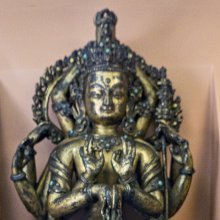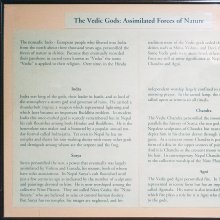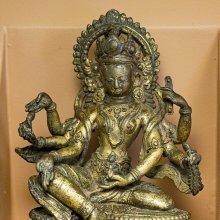Nature: 2 definitions
Introduction:
Nature means something in Hinduism, Sanskrit, the history of ancient India. If you want to know the exact meaning, history, etymology or English translation of this term then check out the descriptions on this page. Add your comment or reference to a book if you want to contribute to this summary article.
Images (photo gallery)
(+15 more images available)
In Hinduism
Natyashastra (theatrics and dramaturgy)
Source: Shodhganga: Elements of Art and Architecture in the Trtiyakhanda of the Visnudharmottarapurana (natya)Nature provides a variety of materials to be used for Ornaments (in Indian Dramas), as conveyed through the Alaṃkāra division of Āhāryābhinaya: one of the four divisions of Abhinaya or “ways to convey or represent one’s emotion to others”, according to the Viṣṇudharmottarapurāṇa, an ancient Sanskrit text which (being encyclopedic in nature) deals with a variety of cultural topics such as arts, architecture, music, grammar and astronomy.—In the Sanskrit dramas ornaments like ear-rings, bracelets, head-gears etc. are seen to be collected from nature. This is informed in many of the Sanskrit dramas. In the Abhijñānaśakuntala, as for example, Śakuntalā is seen to wear flowers, leaves etc. as her ornaments. She is also seen to remain dependant upon nature for her garments. She was wearing the skin of tree as her daily garment. Her clothes were supplied by trees.

Natyashastra (नाट्यशास्त्र, nāṭyaśāstra) refers to both the ancient Indian tradition (shastra) of performing arts, (natya—theatrics, drama, dance, music), as well as the name of a Sanskrit work dealing with these subjects. It also teaches the rules for composing Dramatic plays (nataka), construction and performance of Theater, and Poetic works (kavya).
India history and geography
Source: Suomen Antropologi: Sacred Trees among the Tamil people of South IndiaNature is part of God’s body, according to Hindu thought.—India has a long tradition of venerating and protecting trees and forests. For Hindus, nature as a whole, including the atmosphere, humans, plants and animals, is a part of God’s body and thus divine. In other words, God and nature comprise an inseparable unity. The cosmic law of dharma demands that each Hindu works and cares for the good of nature and humanity. [...] The Vedas glorified nature in hymns created to persuade the gods—basically personifications of forces such as wind, fire or rain—to look upon them kindly.
Another classical Indian text that deals with nature and the environment is the Arthaśāstra, composed by Kautilya during the times of the great kingdoms from 500 BC–AD 300. The scriptures were meant to guide responsible state leaders in maintaining and protecting both natural resources and the well-being of people. Persons responsible for the sustainable use of forest products were expected to have a profound knowledge of botany and numerous plants and trees are listed and classified in the Arthaśāstras, particularly for their use as medical remedies

The history of India traces the identification of countries, villages, towns and other regions of India, as well as mythology, zoology, royal dynasties, rulers, tribes, local festivities and traditions and regional languages. Ancient India enjoyed religious freedom and encourages the path of Dharma, a concept common to Buddhism, Hinduism, and Jainism.
See also (Relevant definitions)
Starts with: Nature vine.
Ends with: Buddha Nature, Madanature, Sinful nature.
Full-text (+7488): Svarupa, Svabhava, Prakriti, Nisarga, Atmatattva, Samsiddhi, Pradhana, Tathata, Tadatmya, Sattvasamshuddhi, Dvaividhya, Prakritika, Atman, Tri-lakshana, Atmaka, Srishti, Dvisvabhava, Strisvabhava, Vajita, Svabhavatva.
Relevant text
Search found 511 books and stories containing Nature; (plurals include: Natures). You can also click to the full overview containing English textual excerpts. Below are direct links for the most relevant articles:
Buddha-nature (as Depicted in the Lankavatara-sutra) (by Nguyen Dac Sy)
2.2. The Buddha-nature and Yogācāra < [Chapter 1 - Evolution of the Buddha-nature Concept]
2. Middle period (b): The Buddha-nature Treatise < [Chapter 2 - The Buddha-Nature in the Tathāgatagarbha Literature]
2. Middle period (c): The Mahāyānasaṃparigraha-śāstra < [Chapter 2 - The Buddha-Nature in the Tathāgatagarbha Literature]
Maha Prajnaparamita Sastra (by Gelongma Karma Migme Chödrön)
I. Tathatā, Dharmadhātu and Bhūtakoṭi < [Part 2 - Understanding dharmatā and its synonyms]
1. Identical characteristics in every Dharma < [Part 4 - Understanding identical and multiple natures]
Emptinesses 7-8: Emptiness of the conditioned unconditioned < [Chapter XLVIII - The Eighteen Emptinesses]
Yoga-sutras (with Vyasa and Vachaspati Mishra) (by Rama Prasada)
Sūtra 2.6 < [Book 2 - Practice (Sādhana)]
Sūtra 2.23 < [Book 2 - Practice (Sādhana)]
Sūtra 4.17 < [Book 4 - Absolute Independence (Kaivalya)]
Yoga-sutras (with Bhoja’s Rajamartanda) (by Rajendralala Mitra)
Sūtra 2.23 < [Second Chapter (Sadhana Pada)]
Sūtra 2.34 < [Second Chapter (Sadhana Pada)]
Shrimad Bhagavad-gita (by Narayana Gosvami)
Verse 9.8 < [Chapter 9 - Rāja-guhya-yoga (Yoga through the most Confidential Knowledge)]
Verse 9.13 < [Chapter 9 - Rāja-guhya-yoga (Yoga through the most Confidential Knowledge)]
Verse 7.20 < [Chapter 7 - Vijñāna-Yoga (Yoga through Realization of Transcendental Knowledge)]
The Tattvasangraha [with commentary] (by Ganganatha Jha)
Related products
(+120 more products available)











